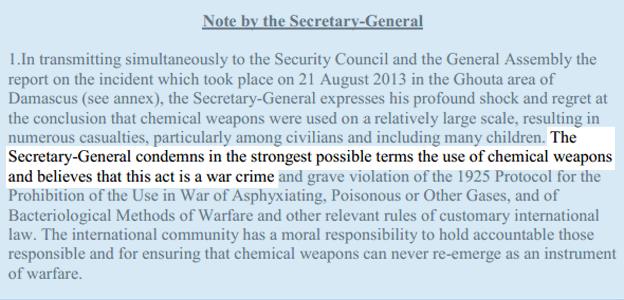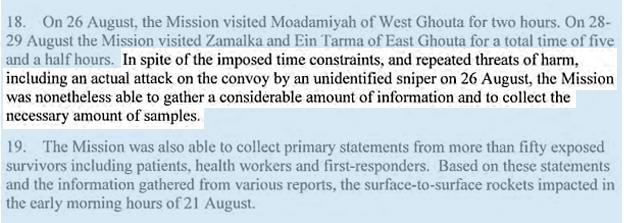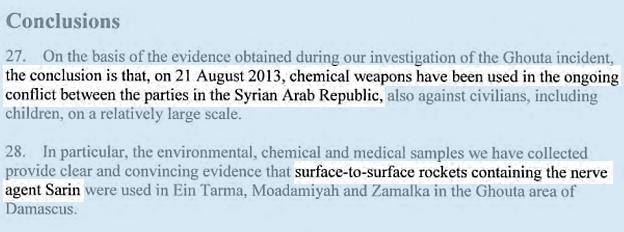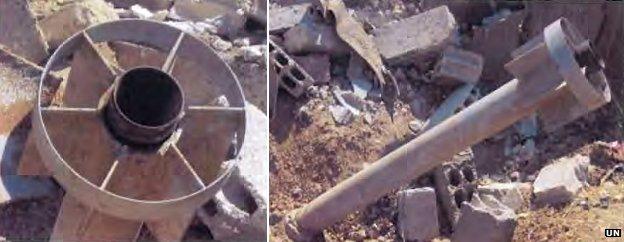Syria chemical attack: Key UN findings
- Published

UN experts began their inspections a week after the attack
Last September, the UN published a much-anticipated UN report, external concluding that chemical weapons were used on a relatively large scale in the Ghouta area of Damascus on 21 August. At the time, the US, UK and France said the report vindicated their stance that the Syrian government was to blame - something Damascus denies. BBC diplomatic correspondent Jonathan Marcus breaks down some of the report's key findings.
The document is prefaced by a note from the UN Secretary General himself - Ban Ki-moon - who reiterates the main conclusion of the UN mission's report and stresses his view that a war crime has been committed and that the international community has a moral responsibility to hold those responsible accountable.
This is a warning that all the evidence collected could ultimately be used in some kind of legal process. It should be remembered that there is already widespread collecting of evidence on the ground to chronicle a variety of atrocities committed by various parties to the conflict.

We have heard the US, British and French intelligence evidence. We have seen the harrowing YouTube videos of victims on the web. This now is the first independent and authoritative confirmation that there is "clear and convincing evidence" that chemical weapons were used on 21 August.
The substance concerned was the nerve agent sarin and the delivery system was ground-to-ground rockets. Note that the UN inspectors do not anywhere in the report explicitly lay the blame for carrying out the attack at the door of Syrian President Bashar al-Assad.
That was beyond the scope of their study, but as we will see a little later, there are strong indicators from their evidence that point the finger at forces loyal to the Assad regime.

The report contains a clear statement of the methodology and approach taken by the inspection team. It also underscores the difficult and hazardous circumstances in which they worked.
However, they state clearly that they were able to collect "the necessary amount of samples". They were also able to interview a number of survivors.

The munitions - unguided rockets - are the key element in this report. Samples of sarin were recovered from the majority of fragments of the warheads.
But more importantly the two types of rocket used - a Russian-supplied 140mm system and especially the larger 330mm weapon of unknown origin - are significant since according to both Human Rights Watch and a number of independent arms experts - these are weapons that have only been observed in use by Syrian government forces during this conflict.
There is significantly more detail on these weapons in the Human Rights Watch report Attacks on Ghouta (caution: disturbing images), external published last September.

The expert blogger Brown Moses has also extensively chronicled the use of the 330mm calibre weapon on his blog, external.
More on the evidence - this time the medical analysis which again shows that victims were exposed to the nerve agent sarin.

So in summary the UN inspectors conclude that chemical weapons were used on a relatively large scale. There has been a whole series of earlier incidents where their use was alleged but these have not been investigated in this kind of detail.

There is much detailed information on the inspectors' findings in the various appendices to the report.
Appendix 5 deals in detail with the munitions used in the attacks. There are photos of the fragments and drawings and measurements describing the weapons in detail.
The 140mm system (M14) clearly has Cyrillic engraving suggesting that this is indeed a munition of Russian origin. The larger 330mm calibre munition is, as mentioned above, of a type used by Syrian government forces.

Images from the UN report of the rockets found in Ein Tarmar and Zamalka
Two caveats are probably worth mentioning: The Syrian rebels have captured significant stockpiles of government weaponry throughout this conflict and as the inspectors' report notes many of the munitions and their fragments had been moved or otherwise tampered with.
However, in some cases the inspectors were able to make an assessment of the likely trajectory of the rockets and this again seems to corroborate US claims that they came from areas controlled by government forces.
